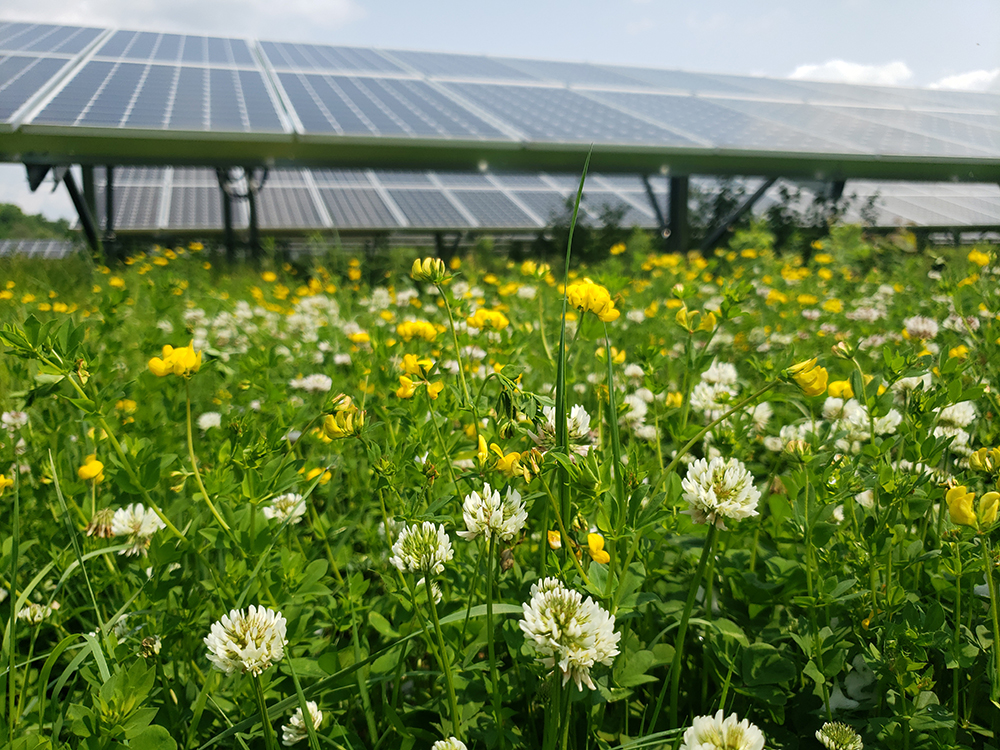
Inspired by the conservationist philosophy that we are “Stewards of the Land,” I apply this philosophy as a civil engineer towards ground-mounted solar photovoltaic (PV) projects throughout New England. Developing and incorporating renewable energy facilities into our existing infrastructure is crucial for our future, however, caution must be exercised when earthwork is involved related to responsible site soil management.
Healthy soil is the basis for all vegetation as it contains a rich combination of organic matter, microorganisms (bacteria, fungi, etc.), and nutrients like carbon, phosphorus, and nitrogen. Soil is a precious and finite natural resource as soil formation is a complex, time-consuming, process. As anyone who has conducted soil testing in New England knows, 12 inches of topsoil may be present in fields, while dense woodlands typically contain half that amount due to the region’s relatively young geological soil age. Healthy soil is essential for solar PV projects, as long-term site maintenance depends on an established meadow cover to mitigate issues such as increased peak-flow runoff velocities and volumes and erosive flows during large storm events. 
The construction phase of these projects often involves disturbing large areas of land – sometimes all at once – to install the racking posts, panels, and utility infrastructure. The highest potential for impacts to downstream receptors that may include water resources typically occur when the site had been primarily or exclusively woodlands. The extensive clearing and grubbing of roots, stumps, and rocks expose site soils to the sun, compromising microorganism health and drying out soils, which in turn degrades soil structure. While revitalizing and protecting recently disturbed site soils is possible, the challenge becomes even greater when rainfall may erode disturbed site soils, leaving the site without a healthy base for the re-establishment of meadow vegetation.
The use of perimeter erosion and sediment controls is an industry standard for land development, including solar PV projects, that aims to protect sensitive off-site resources. A creative and effective strategy of employing these controls towards solar PV projects involves the use of a double-control system incorporating mulch berms made from site-clearing material placed a few feet upslope of traditional sediment barriers like straw wattle, compost filter socks, or a silt fence. This creates two stages of screening sediment-laden runoff while also reducing runoff velocity and allowing sediment to settle in the flow path between the two erosion control barriers.
While traditional erosion controls are necessary for solar PV projects, their effectiveness can be limited as this approach focuses on preventing sediment from leaving the site while not addressing sediment transport within the site. In other words, there is sometimes no established effort to maintain and protect site soil health during construction. Typically, once the array is installed, the entire site is seeded. Unfortunately, germination issues often arise because viable site soils have eroded, leaving seeds to grow in subsoil that is not as supportive of vegetation growth as topsoil. Short-term solutions, such as nutrient loading with fertilizers, are applied which temporarily boost vegetation while potentially increasing the risk of nutrient runoff into downstream water resources. This may result in algal blooms and does not contribute to long-term soil health.
A more innovative approach to preserving soil health during construction of solar PV projects is phased site development. Rather than mass clearing, smaller sections of the site are cleared, stabilized, and protected before moving on to the next section. Immediately following clearing and grubbing, a temporary seed mix can be spread while the soil is still capable of sustaining vegetation. When implemented correctly, by the time the last section of the site is being seeded, germination has occurred in the first section. When phased site development is incorporated during the outset of solar PV projects, projects have a greater potential to be effective at responsible site soil management, along with remaining on schedule. Additionally, where phased development is not feasible, additional construction phase erosion and sedimentation controls such as slope interrupters, erosion control matting, and tackifiers can be implemented.
Understanding that this approach requires a more in-depth engineering and development effort for project planning and site layout, it establishes a crucial goal: maintaining soil health throughout the construction phases of solar PV projects. Utilizing phased site development and/or more robust site erosion and sedimentation controls provides a greater opportunity to create and sustain a healthy, biodiverse meadow ecosystem alongside renewable energy production. By doing so, we can truly embody being “Stewards of the Land.”
Nick Granata, PE, is a project engineer at Weston & Sampson in Manchester, N.H.
 (1).png)







